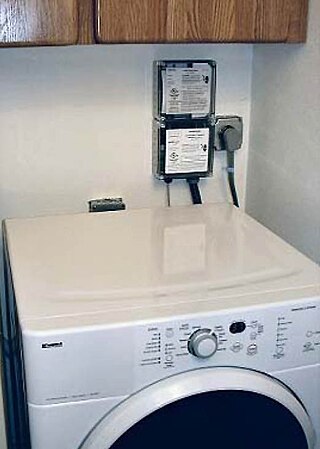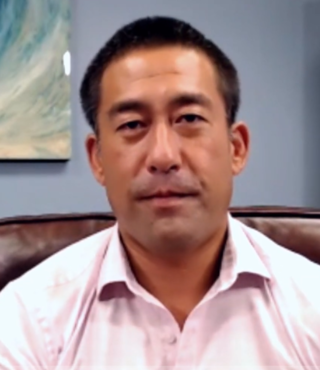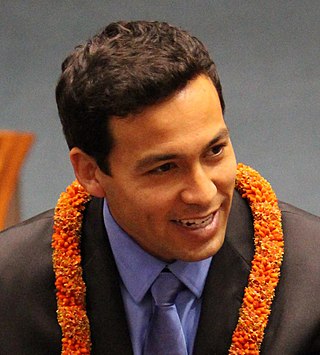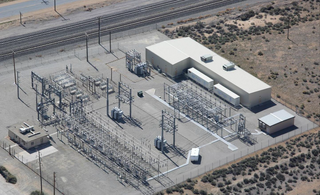
Distributed generation, also distributed energy, on-site generation (OSG), or district/decentralized energy, is electrical generation and storage performed by a variety of small, grid-connected or distribution system-connected devices referred to as distributed energy resources (DER).

Vehicle-to-grid (V2G) describes a system in which plug-in electric vehicles (PEVs) sell demand response services to the grid. Demand services are either delivering electricity to the grid or reducing the rate of charge from the grid. Demand services reduce the peaks in demand for grid supply, and hence reduce the probability of disruption from load variations. Vehicle-to-load (V2L) and Vehicle-to-vehicle (V2V) are related, but the AC phase is not synchronised with the grid, so the power is only available to "off-grid" load.

Demand response is a change in the power consumption of an electric utility customer to better match the demand for power with the supply. Until the 21st century decrease in the cost of pumped storage and batteries, electric energy could not be easily stored, so utilities have traditionally matched demand and supply by throttling the production rate of their power plants, taking generating units on or off line, or importing power from other utilities. There are limits to what can be achieved on the supply side, because some generating units can take a long time to come up to full power, some units may be very expensive to operate, and demand can at times be greater than the capacity of all the available power plants put together. Demand response, a type of energy demand management, seeks to adjust in real-time the demand for power instead of adjusting the supply.
Hawaiian Telcom, Inc., is the incumbent local exchange carrier (ILEC) or dominant local telephone company, serving the state of Hawaii. In 2005, Hawaiian Telcom Holdco, Inc., was formed by The Carlyle Group, following its purchase of the Hawaiian Telcom Inc. assets of Verizon Communications. On July 2, 2018, Cincinnati Bell purchased Hawaiian Telcom Holdco, Inc. for $650 Million,

A smart meter is an electronic device that records information—such as consumption of electric energy, voltage levels, current, and power factor—and communicates the information to the consumer and electricity suppliers. Such an advanced metering infrastructure (AMI) differs from automatic meter reading (AMR) in that it enables two-way communication between the meter and the supplier.
Nova Scotia Power Inc. is a vertically integrated electric utility in Nova Scotia, Canada. It is privately owned by Emera and regulated by the provincial government via the Nova Scotia Utility and Review Board (NSUARB). Nova Scotia Power Inc provides electricity to 520,000 residential, commercial and industrial customers in Nova Scotia.

Hawaiian Electric Industries, Inc. (HEI) is the largest supplier of electricity in the U.S. state of Hawaii, supplying power to 95% of Hawaii's population through its electric utilities: Hawaiian Electric Company serving Oahu, Hawai'i Electric Light Company serving The Big Island, and Maui Electric Company serving Maui, Lanai and Molakai. In addition, HEI owns a financial institution serving Hawaii, American Savings Bank, and a clean energy and sustainability company, Pacific Current LLC.

The smart grid is an enhancement of the 20th century electrical grid, using two-way communications and distributed so-called intelligent devices. Two-way flows of electricity and information could improve the delivery network. Research is mainly focused on three systems of a smart grid – the infrastructure system, the management system, and the protection system. Electronic power conditioning and control of the production and distribution of electricity are important aspects of the smart grid.

Hermina 'Mina' Morita is an adviser for the Hawaii State House Committee on Finance. She is the former chair of the Public Utilities Commission (PUC) of the State of Hawaii. She previously served as a Democratic member of the Hawaii House of Representatives, representing the state's 14th District between her election in 1996 and 2011, when she was appointed to the PUC. The district includes Hanalei, Princeville, and Kapaa on the island of Kauai. Morita was the chair of the House Committee on Energy and Environmental Protection.

The energy sector in Hawaii has rapidly adopted solar power due to the high costs of electricity, and good solar resources, and has one of the highest per capita rates of solar power in the United States. Hawaii's imported energy costs, mostly for imported petroleum and coal, are three to four times higher than the mainland, so Hawaii has motivation to become one of the highest users of solar energy. Hawaii was the first state in the United States to reach grid parity for photovoltaics. Its tropical location provides abundant ambient energy.
The National Association of Regulatory Utility Commissioners (NARUC) is the national association representing the U.S. state public service commissioners who regulate essential utility services, including energy, telecommunications, and water. Founded in 1889, the Association is a resource for its members and the regulatory community, providing a venue to set and influence public policy, share best practices, and foster solutions to improve regulation.

The New York Public Service Commission is the public utilities commission of the New York state government that regulates and oversees the electric, gas, water, and telecommunication industries in New York as part of the Department of Public Service. The department's regulations are compiled in title 16 of the New York Codes, Rules and Regulations. The current chairman of the Commission and chief executive of the Department is Rory M. Christian. His term began on June 10, 2021 and runs through February 1, 2027.
Smart grid policy in the United States refers to legislation and other governmental orders influencing the development of smart grids in the United States.

A photovoltaic power station, also known as a solar park, solar farm, or solar power plant, is a large-scale grid-connected photovoltaic power system designed for the supply of merchant power. They are different from most building-mounted and other decentralized solar power because they supply power at the utility level, rather than to a local user or users. Utility-scale solar is sometimes used to describe this type of project.

Derek S.K. Kawakami is an American politician serving as the eleventh Mayor of Kauai since December 3, 2018. Kawakami previously served as a Kauai County Councilmember from 2016-2018 and 2008-2011 and as a member of the Hawaii House of Representatives from April 4, 2011 through November 8, 2016. Kawakami was appointed by Governor Neil Abercrombie to fill the vacancy caused by the appointment of Hermina Morita to chair the Hawaii Public Utilities Commission. Kawakami is a member of the Democratic Party.

Christopher Kalani Cushman Lee is an American politician and a Democratic member of the Hawaii Senate. He was the youngest member and only millennial serving in the Hawaii State Legislature when elected in November, 2008. He currently serves as Majority Whip and Chairman of the House Judiciary Committee. He also serves on the boards of several non-profit organizations and commissions.
Satcon Technology Corporation was an energy and power company originally based in Cambridge, and later Boston, Massachusetts. Its markets include the utility, hybrid vehicle, ship building, industrial automation, semiconductor processing, and defense.
Mount Signal Solar, also known as Imperial Valley Solar Project, is a 794 MWp (614 MWAC) photovoltaic power station west of Calexico, California, United States, in the southern Imperial Valley, near the Mexican border. The facility was developed and constructed by 8minutenergy Renewables in three phases, with two completed as of 2018, and the third in 2020. It is one of the world's largest PV solar farms with a capacity of about 800 MWp (600 MWAC). The project has been supported by several environmental groups, as the power station was built on low-productivity farmland.
Younicos was a German-American technology company that developed and sold energy storage systems and control software. The company integrated battery technologies, power electronics and control software to create systems that respond to the energy management requirements of power networks of all sizes, including micro-grids.

The Tehachapi Energy Storage Project (TSP) is a 8MW/32MWh lithium-ion battery-based grid energy storage system at the Monolith Substation of Southern California Edison (SCE) in Tehachapi, California, sufficient to power between 1,600 and 2,400 homes for four hours. At the time of commissioning in 2014, it was the largest lithium-ion battery system operating in North America and one of the largest in the world. TSP is considered to be a modern-day energy storage pioneer with significant accomplishments that have proven the viability of utility-scale energy storage using lithium-ion technology. While originally envisioned as a research and development project, TSP operated as a distribution-level resource for SCE and for calendar year 2020, SCE reported that TSP operated in the wholesale energy market with revenue exceeding operating and maintenance costs. In 2021, SCE began the decommissioning of TSP, which was followed by formal decommissioning by state regulators in 2022. The physical dismantlement of TSP is expected to be completed by the end of 2022.











